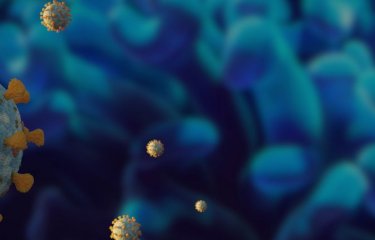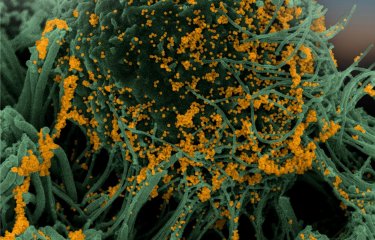Driven by Molecular Insights, Massive Analysis of Medical Records from ~740,000 SARS-CoV-2 Patients Reveal Treatment Regimens for Current, and Potential Future, Viral Pandemics. Published on October 15, 2020, in Science.
In a study published online in Science, an international team of almost 200 researchers from 14 leading institutions in six countries, including France with the Institut Pasteur and CNRS, studied the three lethal coronaviruses SARS-CoV-2, SARS-CoV-1 and MERS-CoV in order to identify commonly hijacked cellular pathways and detect promising targets for broad coronavirus inhibition. In addition, using the molecular insights gained from this multidisciplinary, systematic study of coronaviruses, the group performed an analysis of medical records of approximately 740,000 patients with SARS-CoV-2 that altered clinical outcomes in these patients to uncover approved therapeutics with potential for rapid deployment. These results demonstrate how molecular information can be translated into real-world implications for the treatment of COVID-19, an approach that can ultimately be applied to other diseases in the future.
“This far-reaching international study elucidates for the first time commonalities and, importantly, vulnerabilities, across coronaviruses, including our current challenge with the SARS-CoV-2 pandemic,” said Nevan Krogan, Ph.D., director of the Quantitative Biosciences Institute (QBI) at the School of Pharmacy at UC San Francisco, senior investigator at Gladstone Institutes, and lead investigator of the study. “In unique and rapid fashion, we were able to bridge biological and functional insights with clinical outcomes, providing an exemplary model of a differentiated way to conduct research into any disease, rapidly identify promising treatments and advancing knowledge in the fields of both science and medicine. This body of work was only made possible through the collaborative efforts of senior scientific thought leaders and teams of next-generation researchers at premier institutions across the globe.”
In this collaboration, academic and private sector scientists from UCSF, QBI’s Coronavirus Research Group (QCRG), Gladstone Institutes, EMBL’s European Bioinformatics Institute (EMBL-EBI) in Cambridge, England, Georgia State University, Icahn School of Medicine at Mount Sinai in New York, Institut Pasteur and CNRS in Paris, Cluster of Excellence CIBSS at the University of Freiburg in Germany, University of Sheffield in the UK, and other institutions as well as the companies Aetion, who makes software for analysis of real-world data and genome engineering company Synthego, participated in the research.
Scientific Revelations from a Cross-Coronavirus Study of Protein Function
Building on their previous work published in both Nature and Cell, the researchers studied SARS-CoV-2, SARS-CoV-1 and MERS-CoV comprehensively, using biochemical, proteomic, genetic, structural, bioinformatic, virological and imaging approaches to identify conserved target proteins and cellular processes across coronaviruses. Leveraging the SARS-CoV-2 map of how the SARS-CoV-2 viral proteins interact with their target human host cell proteins, called an “interactome,” the team built the protein-protein interaction maps for SARS-CoV-1 and MERS-CoV, highlighting several key cellular processes that are shared across all three coronaviruses. These common pathways and protein targets represent high-priority targets for therapeutic interventions for this and future pandemics.“Working diligently since the early days of SARS-CoV-2 identification, we came together with the individual strengths of each organization to interrogate the biology and functional activities of these viruses, looking to exploit weaknesses,” commented Veronica Rezelj, Ph.D., of Institut Pasteur[1].
. “In our latest study, we augmented our knowledge base by driving down into two additional coronaviruses, elucidating mechanisms across viruses that allow potential therapeutic interventions.”
Structural Understanding of a Unique Interaction between viral Orf9b and Human Protein Tom70, Which Normally Supports Antiviral Immune Response
Interestingly, the team found that the mitochondrial outer membrane protein Tom70 interacts with both SARS-CoV-1 and SARS-CoV-2 protein Orf9b. Tom70 is normally involved in the activation of mitochondrial antiviral-signaling protein (MAVS) and is essential for an antiviral innate immune response. Orf9b, by binding to the substrate recognition site of Tom70, inhibits Tom70’s interaction with heat shock protein 90 (Hsp90), which is key for its function in the interferon pathway and induction of apoptosis upon virus infection.
In a collaboration among more than 60 scientists in the QCRG led by Klim Verba and Oren Rosenberg at QBI, the structure of Orf9b bound to the active site of Tom70 was determined by cryoelectron microscopy (cryoEM) to a remarkable three-angstrom resolution. A noteworthy and rare finding showed that Orf9b, when by itself, forms a dimer and structurally a beta sheet, but exists as an alpha helix when bound to Tom70. Using the structural image of the bound proteins, the scientists were able to discover that a key residue in the interaction with Hsp90 is moved out of position, suggesting that Orf9b may modulate key aspects of the immune response, interferon and apoptosis signaling via Tom70. The functional significance and regulation of the Orf9b-Tom70 interaction require further experimental elucidation. This interaction, however, which is conserved between SARS-CoV-1 and SARS-CoV-2, could have value as a pan-coronavirus therapeutic target.
Pathway Targets for Potential Clinically-Approved Therapeutics
Using the three coronavirus interactomes as a guide, the team performed CRISPR and RNA interference (RNAi) knockouts of the putative host proteins of each virus and studied how loss of these proteins altered the ability of SARS-CoV-2 to infect human cells. They determined that 73 of the proteins studied were important for the replication of the virus and used this list to prioritize evaluation of drug candidates. Among these were the receptor for the inflammatory signaling molecule IL-17, which has been identified in numerous studies as an important indicator of disease severity; prostaglandin E synthase 2 (encoded by PTGES2), which functionally interacts with the Nsp7 protein in all three viruses; and sigma receptor 1, an interactor of Nsp6 from SARS-CoV-1 and SARS-CoV-2, which the group previously showed was a promising drug target in the laboratory setting.
Armed with this knowledge, the group performed a retrospective analysis of medical billing data from approximately 740,000 people who tested positive for SARS-CoV-2 or were presumptively positive.
In the outpatient setting, SARS-CoV-2-positive, new users of indomethacin, a non-steroidal anti-inflammatory drug (NSAID) that targets PGES-2, were less likely than matched new users of celecoxib, an NSAID that does not target PGES-2, to require hospitalization or inpatient services.
In the inpatient setting, again leveraging the medical billing data, the group compared the effectiveness of typical antipsychotics, namely haloperidol, which have activity against sigma receptor 1, versus atypical antipsychotics, which do not. Half as many new users of typical antipsychotics compared to new users of atypical antipsychotics progressed to the point of requiring mechanical ventilation. Typical antipsychotics can have significant adverse effects, but other sigma receptor 1-targeting drugs exist and more still are in development.
“It is critical to note that the number of patients taking each of these compounds represent small, non-interventional studies,” commented Dr. Krogan. “They are nonetheless powerful examples of how molecular insight can rapidly generate clinical hypotheses and help prioritize candidates for prospective clinical trials or future drug development. A careful analysis of the relative benefits and risks of these therapeutics should be undertaken before considering prospective studies or interventions.”
“These analyses demonstrate how biological and molecular information are translated into real-world implications for the treatment of COVID-19 and other viral diseases,” said Pedro Beltrao, Ph.D., group leader at EMBL’s European Bioinformatics Institute. “After more than a century of relatively harmless coronaviruses, in the last 20 years we have had three coronaviruses which have been deadly. By looking across the species, we have the capability to predict pan-coronavirus therapeutics that may be effective in treating the current pandemic, which we believe will also offer therapeutic promise for a future coronavirus as well.”
Source
Comparative Host-Coronavirus Protein Interaction Networks Reveal Pan-Viral Disease Mechanisms, Science, October 15, 2020





